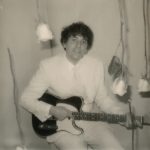There’s a small bar in Seoul whose shelves are lined with Korean LPs from the ‘60s and ‘70s. My friend Kelly Pratt had played Seoul back when he was with Beirut, and he told me about the place, so when my band was lucky enough to play Seoul last year, I asked the promoter if he could take us to “that bar that only plays old Korean records.” I probably didn’t have to ask (and certainly didn’t need to be more specific) — it seemed a popular point of pilgrimage for many Westerners, a living sonic museum of Korea’s vibrant pop/psychedelic/folk traditions from a generation long before the international acclaim of contemporary K-pop.
So I had a few bowls of makgeolli (Korean rice wine) and spent the night listening to lovely acid-tinged records whose names I didn’t know and whose words I couldn’t understand. Shin Joong Hyun’s and Kim Jung Mi’s 1973 Now may not have been played that night, but the following evening, a kind stranger handed me several homemade compilations of music from that era, one of which included Shin and Kim’s gorgeous album.
The record is a paean to Korea’s bucolic natural landscapes, and from its opening moments, Now exudes a pastoral grace. “Haenim” couples a simple acoustic guitar progression with the sober soulfulness of singer Kim Jung Mi’s voice. At nearly seven minutes, the track should feel sprawling, yet Shin’s adept orchestration, replete with nuanced strings and horns, builds the song methodically and seductively — never falling prey to the temptation of bombast or showtunery. The song reaches its climax only three minutes in and circles back to its melodic refrain, finally concluding as it began, with only Kim’s vocal and an acoustic guitar, creating a campfire charm.
They achieve a similar feat on “Spring,” which employs acoustic/orchestral psychedelic folk that wouldn’t feel out of place on any of Leonard Cohen’s first three LPs or the more subdued and melancholic moments of Scott Walker’s late-‘60s albums. Elsewhere, on “Wind,” “Your Dream” and “Ganadaramabasa,” Shin embraces a psychedelic pop sound that could be a distant cousin to contemporaries like Jean-Claude Vannier, who brought the luster to Serge Gainsbourg’s lust-filled 1971 masterpiece, Histoire de Melody Nelson, among other French classics of the period.
But it feels unfair to use western singers, producers and composers as points of comparison for Shin and Kim’s work, especially for this inimitable set of songs. Although Shin developed his sound in part as a result of his exposure to American Armed Forces Radio, all of Now’s songs are sung in Korean. So if this music feels recognizable to this American listener, it’s still foremost an album made explicitly for Koreans. Knowing what we do today about the successful transnational migration of Korean pop music (K-Pop finding chart success in Japan, for instance), it feels more fitting to understand this record as an exemplar of the nascent, then internationally underappreciated, and yet still burgeoning Korean pop music culture of the ‘60s and ‘70s. This scene, however at odds with the materialistic and electronic underpinnings of contemporary K-Pop, offered an early articulation of the belief that Koreans not only can, but should celebrate the vitality of their own culture, while creating art that appeals to those beyond its borders.
Special thanks to G’old Korea Vinyl, which is a great resource for discovering more about the history and development of Korean rock, pop and psychedelic music.



